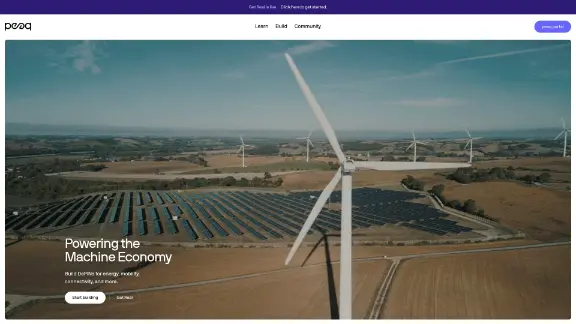peaq (PEAQ)
peaq is a layer-1 blockchain specifically designed to empower the Machine Economy by facilitating Decentralized Physical Infrastructure Networks (DePINs). It serves as a foundational platform for the development and operation of decentralized applications that harness real-world devices, robots, and vehicles. At its inception, peaq became the host to over 50 DePINs across more than 20 industries.
Understanding DePIN
What is DePIN?

| Ticker | PEAQ |
| Category | Smart Contract Platform |
| Website | https://www.peaq.network/ |
| @peaq | |
| Telegram | peaqnetwork |
Decentralized Physical Infrastructure Networks (DePINs) represent a new paradigm in decentralized applications. They leverage token systems to incentivize communities in building and maintaining physical infrastructure networks. These networks span various sectors, including mobility, electric vehicle charging, and telecommunications. DePINs are integral to peaq's ecosystem, offering a robust framework for developing decentralized and community-driven infrastructure solutions.
Why do DePINs build on peaq?
peaq provides an ideal environment for DePINs due to its focus on real-world Web3 applications. It offers Modular DePIN Functions, such as Machine IDs and DePIN Data Verification, which act as essential building blocks for the rapid development and deployment of DePINs. Additionally, peaq's ecosystem fosters collaboration among DePINs and provides access to an enterprise-focused ecosystem that expands market opportunities. The blockchain's architecture ensures affordable, fast transactions and a high degree of decentralization, making it a preferred choice for DePIN developers.
Building on peaq
peaq's platform supports the creation of decentralized applications that interact with real-world devices to deliver diverse services. Below are some notable projects developed on peaq:
Notable projects built on peaq
Silencio
Silencio is a DePIN project that has developed the world's largest crowdsourced noise pollution map. Users participate via a mobile app, collecting local noise data and receiving token rewards. Silencio boasts a user base of over 360,000 individuals across 180 countries, illustrating the global reach and impact of DePINs on peaq.
XMAQUINA
XMAQUINA is a tokenization platform for autonomous robots, responsible for launching the first tokenized automatic robo-cafe. This initiative highlights peaq's capability to support innovative solutions in the field of robotics and automation.
Farmsent
Farmsent is a DePIN focused on smart agriculture and operates a peer-to-peer marketplace for farm produce. It has successfully onboarded more than 160,000 farmers in Asia and South America, showcasing peaq's potential in transforming agricultural practices through decentralized technology.
MapMetrics
MapMetrics is a drive-to-earn DePIN that incentivizes users to collect navigation data via a mobile application. With a community of 60,000 users, MapMetrics exemplifies how peaq enables data-driven applications for enhanced mobility solutions.
Teneo Protocol
Teneo Protocol is a DePIN that facilitates the crowdsourcing of real-time social media data through over 250,000 Community Nodes. This project underscores peaq's potential in revolutionizing how data is gathered and utilized in the digital information landscape.
Collaboration with enterprises
peaq collaborates with leading enterprises to advance its ecosystem and expand its technological capabilities. Notably, peaq is working with renowned IoT manufacturers such as Bosch and participates in the Bosch-led moveID project, which includes industry giants like Airbus and Continental. Additionally, peaq collaborates with Mastercard, highlighting its commitment to integrating blockchain solutions with established industry players.
For further exploration of the peaq ecosystem and its collaborations, visit the official peaq website.
